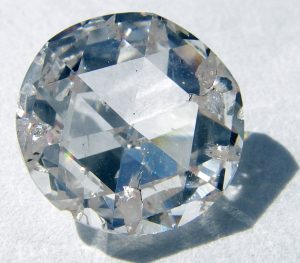Brutally Cheap Fashion
A Conflict Free Alternative to Naturally Mined Diamonds
How consumer demand for conflict free diamonds has given way to lab created counterparts
Kathryn Petersen

This past January, a Facebook friend of mine got engaged. The obligatory “We’re engaged!” post from the couple and their parents celebrated the exciting moment. Comments of congratulations and excitement followed the photos of the couple with a gorgeous engagement ring.
A marriage proposal serves as the representation of a lifetime union. It’s a big moment. But what about the ring? Aside from commenting on its sparkle or asking who picked it out, the origins of our engagement rings aren’t typically the center of our attention.
The origins of our diamonds
65% of the world supply of diamonds can be traced to Africa and, according to Human Rights Watch, were mined under brutal conditions (Becker, 2018). The term conflict, or “blood” diamonds, are diamonds that are “illegally traded to fund conflict in war-torn areas.” (Armstrong, 2011).
Cases studied by Human Rights Watch have exposed the terrible mining conditions of our diamonds. HRW reports of children working with deadly materials in insecure mines set to collapse at any moment – not to mention the violence caused by the armed groups seeking control of these mines. What we use as a symbol of our commitment and love for our partner is at the same time, a product of atrocious human rights violations.
What we use as a symbol of our commitment and love for our partner is at the same time, a product of atrocious human rights violations.
Diamonds have funded civil wars in countries such as Angola and Sierra Leone. Rebel groups perpetuated human rights violations such as the use of child labor, bonded labor, massacres, violence, and sexual assaults (Diamonds for Peace). The working conditions are incredibly dangerous as many mines collapse. Even in countries without civil wars and rebel groups, diamond mining has been described as “Modern Slavery.”

In 2002, the Kimberley Process came into effect to stop the flow of blood diamonds used to finance wars in Africa. The Kimberley Process is a certification system that serves as an attempt to “implement safeguards on shipments of rough diamonds” and certify them as conflict free by requiring producers to attach legitimate origin certificates to each diamond. (Kimberley Process, 2020). The Kimberley Process only seeks to prevent the flow of diamonds that are sold to fund rebel insurgencies and regional violence by issuing origin certifications that accompany the shipment of diamonds as they exchange hands (Baker/Tshikapa, 2018).
While the Process does decrease the number of illegally traded diamonds, it “remains riddled with loopholes” because blood diamonds are mined in war zones. Even when governments commit egregious human rights offenses, the Kimberley Process will still certify diamonds as long as they did not fund rebel insurgencies (Baker/Tshikapa, 2018). In fact, when a Zimbabwean army brutally murdered more than 200 miners after seizing mines, the Kimberley Process still certified the diamonds mined from the violence, because the diamonds did not fund rebel groups (Baker/Tshikapa, 2018). In the Central African Republic, diamonds helped fund a genocide of thousands – yet the Process did not flag these diamonds as conflict diamonds because they did not fund rebel groups (Presnall, 2019).
A 2015 Amnesty International report called for diamond companies to stop hiding behind the “veneer of respectability offered by the Kimberley Process rather than taking responsibility for what happens along their supply chains” (Amnesty International, 2015). Jewelers, however, rely on the Kimberley Process to sell diamonds that are Kimberley certified yet they very easily could trace back human rights violations. In shopping for a diamond myself, the salespeople assured me that the entire store had only conflict free diamonds. “How can you confirm that these diamonds are conflict free?” I would ask. The salespeople referred to the Kimberley Process and stated that every single diamond was “certified conflict free.” Many of the jewelers I visited, however, could not distinctly state the origins of the diamonds and the hands that touched it.
Despite claims that jewelers only sell conflict free diamonds, Human Rights Watch attempts to inform consumers about the unknown price behind their diamonds. In a February 2018 tweet, representatives urged consumers to reconsider their purchases for Valentine’s Day. Citing the United Nations Guiding Principles on Business and Human Rights, HRW assessed the governance, standards, and certification systems of gems and examined the practices of well-known companies. Most companies “still fall short of meeting international standards” and simply rely on the assurances of their suppliers that their gems are free of human rights abuses, instead of validating that claim (Becker, 2018). None of the companies that willingly engaged in the audit received an excellent rating and fulfilled all the criteria for responsible sourcing.
It has become clear that the Kimberley Process and the promise from jewelry stores that diamonds are conflict free are not assurances to the origins of the gem. A growing demand, spearheaded by younger generations, has paved the way for an alternative to traditionally mined diamonds.
Demands for an alternative
Amidst demands for an alternative, scientists created diamonds in a lab. While naturally occurring diamonds were typically formed between one billion and three billion years ago, lab mined diamonds are grown in six months in a machine (Constable, 2020). While naturally occurring diamonds were typically formed between one billion and three billion years ago, lab mined diamonds are grown in six months in a machine. There are two ways to replicate a naturally mined diamond while avoiding human rights abuses and the shifting of an estimated 250 tons of earth required to mine a single carat of a diamond (Constable, 2020). A high pressure-high temperature diamond requires a “diamond seed” and is heated to 1500 degrees Celsius while pressurized to 1.5 million pounds per square inch – resulting in an unpolished carbon diamond (Stanford Daily Sponsored Content Team, 2019). Chemical Vapor Deposition also requires a diamond seed that is heated to 800 degrees Celsius and filled with carbon-rich gas which then crystallizes on the diamond seed (Stanford Daily Sponsored Content Team, 2019).

Lab mined diamonds have become more prominent in the jewelry industry due to their visual similarities to naturally mined diamonds. In my own exploration of lab mined diamonds, I decided to understand how jewelers sell these diamonds closer to home. At jewelry stores, the diamond buying guide describes the “4 C’s of Diamonds” to inform consumers on how to evaluate a diamond’s quality. The quality and value of a diamond are defined by its level of the 4C’s: Cut, Color, Clarity, and Carat. Cut and carat are typically the known entities before walking into a jewelry store. The cut is the symmetry and dimensions of the diamond and the carat is the weight of the diamond. Color and clarity, however, are defined by a gradient. Most diamonds have blemishes and inclusions, and they are measured to the extent that the blemishes and inclusions are visible to the naked eye.
In researching diamonds, I visited a jewelry store in Bloomington, Indiana. Placing several engagement rings on the counter, the representative showed me a mined diamond with a strong inclusion. She laughed at the diamond, claiming they would likely send it back to corporate as she didn’t think it matched the store’s standards. I took a look and saw what looked like to be a distracting ink stain on the diamond itself. She continued the mined diamond explanation with several mined diamonds that were only slightly included. These inclusions couldn’t meet the naked eye, making them more valuable and more expensive. Mined diamonds aren’t perfect. They are a product of our environment.
But how do lab mined diamonds measure up to the 4C’s?
At a jewelry store in College Mall in Bloomington, Indiana, a representative kindly walked me over to the section with a display of engagement rings. In the middle of the jewelry case was a rotating display. A huge round-cut diamond sparkled and slowly rotated to catch my attention. At the bottom read “Lab mined diamonds.” Pointing to the display, I asked about the difference between lab mined diamonds and naturally mined diamonds. The representative looked at me strangely and asked me to clarify what I meant by “difference.” I realized that even in my own research, I perpetuated the misconception that there even was a difference.
“Lab mined diamonds are diamonds,” the representative corrected. The representative is referring to the properties of lab mined diamonds, as well as a 2018 Federal Trade Commission ruling, claiming that both mined and lab-grown diamonds are, in fact, diamonds. Before 2018, they had mostly been preceded by the word “synthetic.”
I asked to see a few lab diamonds. The representative reminded me that the lab diamonds are classified in the same way. The same 4 C’s apply. “Think of it like a greenhouse,” she said. “Flowers that grow in a greenhouse are coming from the same seed and are grown in the same condition, yet they still turn out different. Some could have larger leaves than another and maybe some have a problem with the stems.”
But there really isn’t a difference, she confirmed. She clarified with another analogy. “I don’t know if this makes sense, but it’s like having a baby. When you have a baby, how would you know if you had IVF or went to a sperm bank or just had a baby the old-fashioned way. It’s a baby, with different characteristics because of genetics.” In this case, lab mined diamonds are the babies, and the different characteristics are simply the ways they came about. The physical properties of the diamonds are actually the same.
What’s in the market of lab grown diamonds?
After I understood what they were, I asked a few representatives who bought the naturally mined diamonds versus the lab grown. “Typically, older clients are looking for mined diamonds,” she said, adding that they had a very specific idea of what a diamond should be.
While older generations have an idea of what a diamond should be, there is no difference between the two. While older generations have an idea of what a diamond should be, there is no difference between the two. The representative claimed that when older clients find out the diamond they might consider purchasing actually came from a lab, they decide it couldn’t possibly be a real diamond.
While older generations are put off by the specific origins of their diamond, younger consumers are actually more likely to purchase a larger lab grown diamond for a price averaging 30% less than a naturally mined smaller diamond (Danziger, 2020). The representative confirmed the trend in the U.S. market. Lab mined diamonds are on average about 30% cheaper than their mined counterparts (Danziger, 2020). “You’re just buying the product,” she said, “not the land or the labor that goes into mining the product.” Cheaper prices allow jewelers to sell their diamonds at a greater profit margin (Baker/Tshikapa, 2018).
“I really think it’s because there isn’t enough information out there, like on the internet,” claimed the representative, as a response to my question on why lab grown diamonds aren’t as popular as we would think.
Why do we still have misconceptions about lab diamonds as not being the “real” thing? In scouring the internet myself, only recent articles stray away from the word “synthetic.” Reports dating all the way up to 2019 still use the word “synthetic” and allude that the diamond is fake. A simple Google search asking whether or not I should buy a lab grown diamond generates three top articles either listing the reasons that I should not buy a lab grown diamond or claiming that lab grown diamonds aren’t real (in direct conflict with the 2018 Federal Trade Commission statement). The information on the internet, while now leaning towards the recognition of lab grown diamond as real diamonds, still contains misinformation surrounding the truths about lab grown diamonds.
Lab grown diamonds are not without their faults. Some argue that blood diamonds – despite the human rights abuses and horrific mining conditions – are a vital source of income for the poor. Some argue that there is still an ecological footprint for the creation of lab mined diamonds. Such concerns should be explored further. It is, however, safe to say that lab mined diamonds are without the concern of human rights abuses.
Given an increase in information within this past year and the increase in millennials and Gen-Z shopping for diamonds, it is likely that we will see a newfound interest in lab created diamonds. Companies such as Brilliant Earth are founded under the mission of conflict-free and lab created diamonds. Tabloid magazines depict celebrities such as Meghan Markle, who now wears lab grown diamonds, as we experience a wave of societal acceptance for the “realness” of lab grown diamonds. Despite the asymmetry between societal expectations and habits versus scientific findings, I predict there will be a greater increase in the purchase of lab grown diamonds.
As consumers, when there is a better alternative to a product, we sometimes don’t even recognize it. Societal misconceptions on what is real versus fake cloud our judgment when purchasing products such as diamonds. We are instead intrigued and drawn to what seems natural and rare – in this case, naturally mined diamonds. It’s important to ask ourselves, what’s the better alternative? And trust those who are certified to judge those alternatives.
References
Amnesty International. (2015). Time for diamond companies to stop hiding behind Kimberley Process. Retrieved from Amnesty International.
Armstrong, P. (2011, December 5). What are ‘conflict diamonds?’. CNN.
Baker/Tshikapa, A. (2018). Blood Diamonds. Time.
Becker, J. (2018). The Hidden Cost of Jewelry. Retrieved from Human Rights Watch.
Benjamin, C. (2020, July 2). US jewelry store diamond sales pick up in May as consumers return – analysts. S&P Global – Market Intelligence.
Constable, H. (2020, February 9). The sparkling rise of the lab grown diamond. BBC Future Planet.
Danziger, P. (2020, October 30). Lab-grown diamonds need to be on every jewelry store’s shopping list. Forbes.
Diamonds for Peace. (n.d.). Human Rights. Retrieved from Diamonds for Peace.
Kimberley Process. (2020). What is the Kimberley Process? Retrieved from Kimberley Process.
Presnall, A. (2019, December 23). Diamonds: A Symbol of Love and Conflict. University of Alabama Institute for Human Rights.
Shimansky. (2020). Why USA is the biggest diamond consumer. Retrieved from Shimanksy Cape Town – New York.
Stanford Daily Sponsored Content Team. (2019, September 27). The science behind lab-created diamonds. The Stanford Daily.
